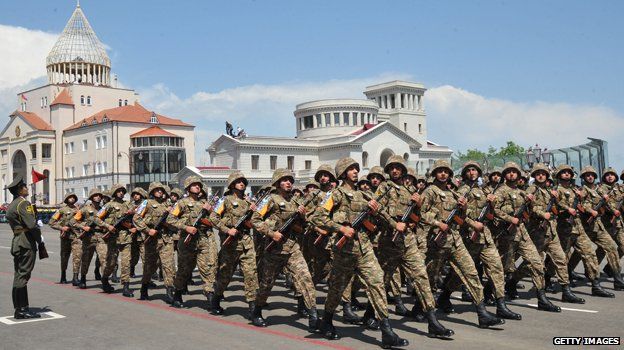Armenia, Azerbaijan Tensions Flare Again Since 1994 Truce
By Matthew Schaller
Staff Writer
Hostilities between Armenia and Azerbaijan reached a boiling point overnight as a result of the contested Nagorno-Karabakh region. As to who is the provocateur of this recent conflict, each sides’ respective defense ministries accused the other of provoking this escalation.
Azerbaijan stated that Armenian troops were using heavy machine guns and mortars over a 24 hour period while Armenia said that Azeri troops were using tanks, military aircraft, and artillery in an apparent overnight offensive.
In the disputed republic of Nagorno-Karabakh, militias claimed they shot down two Azeri helicopters and two attack drones. According to Reuters, Yerevan, the capital of Armenia, considers these forces independent of theirs, while Baku, the capital of Azerbaijan, considers them Armenian.
Speaking at the Nuclear Security Summit in Washington, D.C., Azerbaijan President Ilham Aliyev accused Armenia of setting the conditions for the liberation of the area, but said that his country “will continue efforts aimed at a peaceful resolution of the conflict.”
No matter who started this dispute, it still hasn’t prevented the international community from getting involved. The OSCE Minsk group, which is tasked with overseeing this contested area and is co-chaired by Russia, the US, and France, released a joint statement expressing their concern of the hostilities.
In addition, Russian Defense Minister Sergey Shoigu held emergency talks with his counterparts in Azerbaijan and Armenia in order to seek ways of finding a peaceful resolution to hostilities.

While both parties to the conflict have made the use of weapons the standard, water or, more specifically, access to it, has once again taken center stage with the recent flare-up. When the 1994 truce was enacted between the two countries, Azerbaijan lost, in addition to territory, access to the 560 million cubic meters of the Sarsang Reservoir.
The reservoir, built on the Tartar River and situated in Nagorno-Karabakh, was built in 1976 and used to provide a means of irrigation for the remote region, and also the six surrounding areas that are now controlled by separatist and Armenian forces. The Azerbaijani-controlled area of Tartar is one of these surrounding areas, and is situated on the line of contact between the two countries.
These forces cut off the water supply in the summer causing the lack of water to affect the biodiversity of the area. The floodgates are re-opened in the fall, but the damage is already done.
Bakhtiyar Mammadov, an internally displaced individual by way of the conflict, stated that the situation has become desperate as a result of agricultural products “being destroyed in front of our eyes.” Using a third of his house’s quarter of an acre plot of land to grow fruits and vegetables has become impossible because “…irrigation totally depends on the Sarsang Water Reservoir, and we can’t use our gardens in the summertime.”
To account for the lack of water, people have resorted to digging ditches, constructing wells, and even collecting scrap metal to be sold in town for bottled water. Despite no sign from either side wanting to resolve this issue, both can agree to this being a humanitarian issue and it presents a good basis for talks.
The two former Soviet republics are trapped in a decade’s long squabble over the contested Armenian, mountainous region that was formerly a part of the Azerbaijani SSR. With independence being declared in 1991 and a three year war following it, Russia stepped in and was able to broker a truce between the two countries. Nevertheless, the animosity and mistrust has always remained, and it remains to be seen if this recent flare-up will be any different.


